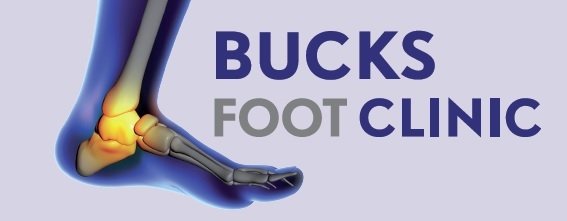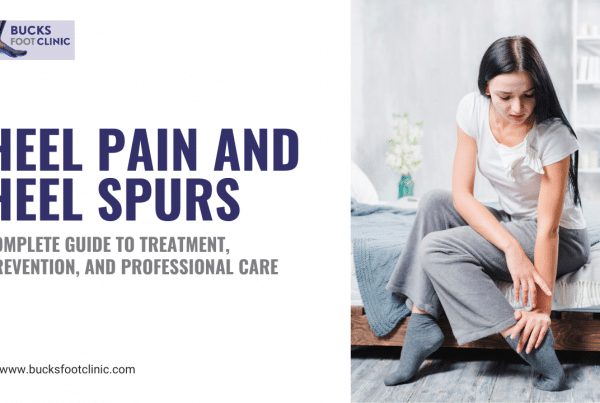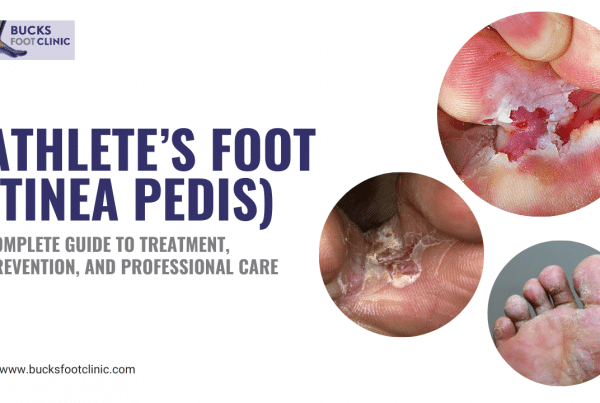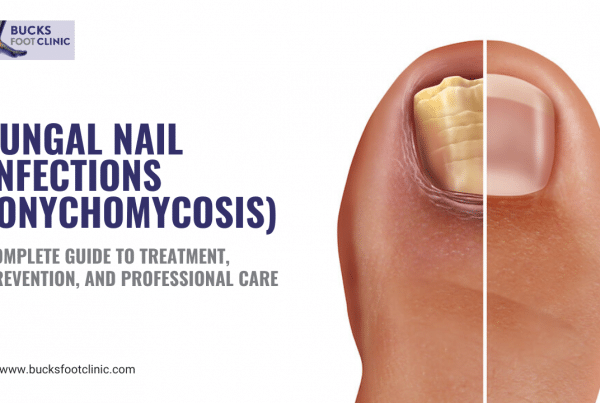
The Best Over-the-Counter Toenail Fungus Treatments (And When to Visit Bucks Foot Clinic in Amersham)
When you first notice yellowing, thickening, or crumbling toenails, your initial instinct might be to head to your local Amersham pharmacy for an over-the-counter solution. Whilst some pharmacy treatments can help mild, early-stage infections, understanding their limitations—and knowing when professional intervention is essential—can save you months of frustration and hundreds of pounds in ineffective treatments. As the leading provider of the best toenail fungus treatment Amersham has to offer, Bucks Foot Clinic sees countless patients who’ve exhausted pharmacy options before seeking the professional care that actually resolves their infection. This comprehensive guide honestly evaluates over-the-counter treatments, reveals which ones podiatrists actually recommend, and clearly explains when it’s time to book an appointment with the specialists offering proven Bucks Foot Clinic fungal nail remedies that work where retail products fail.
Understanding Why Most Over-the-Counter Treatments Disappoint
The fundamental challenge with over-the-counter toenail fungus treatments lies not in their active ingredients but in their inability to reach the infection site. Fungal organisms colonise the nail bed, protected by the overlying nail plate—a barrier that most topical treatments cannot penetrate effectively. This structural obstacle means that even scientifically sound antifungal ingredients remain on the nail surface rather than reaching the fungi beneath.
Marketing claims often exploit desperate consumers, promising quick results that clinical evidence doesn’t support. Studies show that over-the-counter topical treatments achieve complete cure rates of less than 10%, even with perfect compliance over many months. This dismal success rate reflects the biological reality that nail keratin is specifically designed to be impermeable, protecting the sensitive nail bed from external threats—unfortunately, this same protection prevents therapeutic agents from reaching fungal infections.
The situation in Amersham’s damp climate further challenges treatment success. Our local humidity levels, particularly during autumn and winter months, create conditions favouring fungal persistence. Even if over-the-counter treatments temporarily suppress visible symptoms, the underlying infection often persists, leading to rapid recurrence once treatment stops. This explains why many Amersham residents cycle through multiple pharmacy products without achieving lasting resolution.
Additionally, self-diagnosis accuracy remains problematic. Approximately 50% of nail abnormalities that appear fungal actually result from other conditions—trauma, psoriasis, bacterial infections, or age-related changes. Using antifungal treatments for non-fungal conditions wastes time and money whilst the real problem worsens untreated.
The Most Effective Over-the-Counter Options Available
Amorolfine 5% Nail Lacquer (Loceryl, Curanail)
Among pharmacy options, amorolfine-containing lacquers show the best clinical evidence, though success rates remain modest. This prescription-strength-turned-OTC treatment works by disrupting fungal cell membrane synthesis. Applied once or twice weekly after filing the nail surface, it can achieve improvement in 40-50% of cases, though complete cure occurs in fewer than 15% of users.
The key to any success with amorolfine lies in meticulous application technique and patience. File down infected nail areas before each application, remove old lacquer with nail polish remover, and continue treatment for 6-12 months. Most failures result from premature discontinuation when visible improvement plateaus. Even successful treatment requires continued application for three months after the nail appears clear to prevent recurrence.
Terbinafine-Based Solutions
Whilst terbinafine tablets (prescription-only) effectively treat fungal nails, over-the-counter terbinafine creams and sprays designed for athlete’s foot show minimal efficacy for nail infections. These formulations cannot penetrate the nail plate adequately. However, applying terbinafine cream to the surrounding skin and nail folds might prevent spread and treat concurrent fungal skin infections that often accompany nail problems.
Some newer terbinafine nail solutions claim improved penetration through proprietary delivery systems. Whilst theoretically promising, independent clinical evidence remains limited. The HCPC-registered podiatrists at Bucks Foot Clinic can advise whether these newer formulations merit trial based on your specific infection characteristics.
Tea Tree Oil Preparations
Natural remedy enthusiasts often turn to tea tree oil, which does possess antifungal properties. Laboratory studies confirm tea tree oil kills common nail fungi, but clinical trials show disappointing real-world results. The oil’s inability to penetrate the nail plate sufficiently limits its effectiveness to very superficial infections.
If attempting tea tree oil treatment, use 100% pure oil applied twice daily with a cotton swab, focusing on the nail edges and cuticle area where penetration is slightly better. Combine with gentle filing to thin the nail. Expect minimal improvement for established infections, though it might help prevent spread to adjacent nails.
Urea-Based Treatments (Canespro, Excilor)
These products work differently, using 40% urea to chemically soften and dissolve infected nail tissue rather than directly killing fungi. After two weeks of application under occlusive dressings, the softened nail can be scraped away, potentially removing infected material. This approach might help when combined with antifungal treatments by improving their penetration.
However, the process requires careful application to avoid damaging surrounding skin, and complete infection removal rarely occurs since fungi extend into the nail bed. The specialists at Bucks Foot Clinic perform professional debridement more safely and effectively, achieving better infected tissue removal without risking healthy tissue damage.
Combination Products
Some newer products combine multiple approaches—antifungals with penetration enhancers, or antifungals with nail-softening agents. Whilst logical in principle, these combinations still face the fundamental penetration barrier. They might show slightly better results than single-ingredient products but rarely achieve the complete cure patients seek.
How to Prevent Toenail Fungus Infections
- Maintain Dry Foot Environment
Fungi thrive in moisture, making dry feet your first defence line. After bathing, thoroughly dry between toes using a hairdryer on cool setting if necessary. Apply antifungal powder to feet and inside shoes daily, especially during Amersham’s humid months. Change socks immediately if they become damp from sweat or rain. Consider moisture-wicking socks for exercise and waterproof footwear during our frequent rainy periods.
- Practice Strict Hygiene Protocols
Wash feet daily with antibacterial soap, paying attention to nail edges and between toes. Disinfect nail tools after each use with 70% alcohol or 10-minute boiling water immersion. Never share nail implements, even within families. Keep separate tools for infected and healthy nails to prevent spread. Replace emery boards regularly as they harbour fungi in their porous structure.
- Choose Preventive Footwear Strategies
Rotate shoes daily, allowing 48 hours drying time between wears—crucial in Amersham’s damp climate. Select breathable materials like leather or canvas over synthetic alternatives. Use antifungal shoe sprays weekly, paying attention to toe box areas. Replace worn trainers that retain moisture despite drying attempts. Consider cedar shoe trees that naturally resist fungal growth whilst maintaining shoe shape.
- Protect Feet in High-Risk Environments
Always wear waterproof sandals in public showers, pools, and changing rooms—particularly at Amersham’s leisure facilities where warm, moist conditions favour fungal transmission. Avoid barefoot walking in hotels, gyms, or other public spaces. After swimming, dry feet thoroughly and apply antifungal powder before putting on socks and shoes.
- Address Predisposing Factors
Manage conditions increasing infection risk: control blood sugar if diabetic, treat excessive foot sweating with antiperspirants or iontophoresis, and address circulation problems through exercise and smoking cessation. Maintain healthy weight to reduce foot pressure and sweating. Keep toenails properly trimmed to prevent trauma that creates fungal entry points.
- Early Intervention Strategy
At first sign of nail discolouration or thickening, begin preventive measures immediately. Apply over-the-counter antifungal lacquer to affected and adjacent nails. Increase hygiene vigilance and consider professional assessment if improvement doesn’t occur within four weeks. Early professional intervention at Bucks Foot Clinic prevents progression to difficult-to-treat established infections.
Why Professional Treatment at Bucks Foot Clinic Surpasses Pharmacy Options
Accurate Diagnosis Through Expert Assessment
The specialists providing Bucks Foot Clinic fungal nail remedies begin with proper diagnosis—crucial since only 50% of abnormal-appearing nails are actually fungal. Their B.Sc. Podiatric Medicine training enables differentiation between fungal infections, nail psoriasis, trauma-induced changes, and other conditions. This expertise prevents wasted time treating the wrong condition with inappropriate remedies.
Using dermatoscopy and clinical examination, they identify specific infection characteristics guiding treatment selection. When necessary, they perform nail sampling for laboratory confirmation, ensuring accurate diagnosis before beginning treatment. This scientific approach contrasts sharply with the guesswork inherent in self-treatment attempts.
Professional-Grade Treatment Technologies
Bucks Foot Clinic offers the best toenail fungus treatment Amersham residents can access, including technologies unavailable in pharmacies. Their SWIFT microwave therapy represents breakthrough treatment, using controlled microwave energy to eliminate fungi whilst stimulating immune response. This innovative approach achieves success rates exceeding 75% for appropriate candidates.
Photodynamic therapy, another exclusive offering, uses light-activated compounds to destroy fungal cells whilst preserving healthy tissue. These advanced treatments work when over-the-counter options fail, providing hope for those with resistant infections who’ve exhausted pharmacy alternatives.
Mechanical Debridement Expertise
Professional nail reduction dramatically improves treatment outcomes by removing infected tissue and improving medication penetration. The podiatrists at Bucks Foot Clinic use specialised equipment to safely thin thickened nails and remove debris accumulation—procedures impossible to replicate at home safely.
This mechanical intervention provides immediate cosmetic improvement whilst accelerating healing. Regular professional debridement during treatment maintains optimal conditions for healthy nail regrowth, something over-the-counter treatments cannot provide.
Prescription Medication Access
When appropriate, Bucks Foot Clinic’s HCPC-registered podiatrists prescribe oral antifungal medications achieving 70-80% cure rates—far exceeding any over-the-counter option. They monitor for side effects, adjust dosing based on response, and combine systemic treatment with topical therapies for optimal outcomes.
Their ability to prescribe extends to professional-strength topical preparations unavailable in pharmacies. These prescription formulations contain higher active ingredient concentrations and superior penetration enhancers, dramatically improving treatment success compared to retail products.
Comprehensive Management Approach
Unlike single-product pharmacy treatments, Bucks Foot Clinic implements multi-modal strategies addressing all infection aspects. Combining mechanical debridement, targeted medications, preventive education, and follow-up monitoring creates synergistic effects exceeding any individual treatment. This comprehensive approach explains their superior success rates compared to over-the-counter attempts.
According to the NHS guidance on fungal nail infections, professional treatment is often required when pharmacy options fail.
How to Fix Fungal Nail Problems Effectively
- Optimise Over-the-Counter Treatment Success
If attempting pharmacy treatment, maximise success chances through proper technique. File infected nail areas weekly before applying medication, reducing thickness for better penetration. Apply treatments to all nails on affected foot, not just visibly infected ones, as subclinical infection often exists. Continue treatment for three months after nails appear clear to prevent recurrence. Document progress with monthly photographs to objectively assess improvement.
- Combination Approach Strategy
Combine different over-the-counter mechanisms for potentially better results. Use urea-based softeners to thin nails, followed by antifungal lacquers for improved penetration. Add tea tree oil to nail edges where absorption is better. Whilst still limited by penetration barriers, combination approaches might achieve better results than single treatments.
- Know When to Abandon Home Treatment
Set realistic timeframes for over-the-counter trials. If no improvement occurs within three months of consistent use, professional assessment is indicated. Continue deterioration despite treatment, spread to additional nails, or development of pain all mandate immediate professional evaluation at Bucks Foot Clinic rather than trying additional pharmacy products.
- Prepare for Professional Consultation
Before visiting Bucks Foot Clinic, document your treatment history: which products used, duration of use, any temporary improvements, and side effects experienced. Photograph your nails to show progression. List any medications you take and health conditions you have. This information helps podiatrists tailor treatment plans and avoid previously failed approaches.
- Integrate Professional and Home Care
The most effective approach often combines professional treatment at Bucks Foot Clinic with appropriate home care. Professional debridement improves penetration of home-applied treatments. Prescription medications work synergistically with over-the-counter adjuncts. This integrated approach achieves better outcomes than either approach alone.
- Prevent Recurrence After Successful Treatment
Whether achieved through pharmacy products or professional care, maintaining clear nails requires ongoing vigilance. Continue preventive measures indefinitely: antifungal powder in shoes, strict hygiene protocols, and immediate treatment of any suspicious changes. Schedule annual check-ups at Bucks Foot Clinic to catch recurrence early.
Making the Right Treatment Decision
The choice between persevering with over-the-counter treatments or seeking professional care depends on several factors. Early, mild infections in otherwise healthy individuals might respond to pharmacy options, though success remains unlikely. However, established infections, multiple nail involvement, or presence of risk factors like diabetes mandate immediate professional assessment.
Consider the hidden costs of failed self-treatment: months of purchasing ineffective products, progression to more severe infection, spread to additional nails, and psychological impact of persistent unsightly nails. When totalled, these costs often exceed professional treatment at Bucks Foot Clinic, which offers higher success probability and faster resolution.
The Amersham Advantage: Local Expert Care
For Amersham residents, having Bucks Foot Clinic nearby eliminates barriers to professional treatment. Rather than travelling to London or Reading for specialist care, you can access the best toenail fungus treatment Amersham offers just minutes from home. The clinic’s established reputation in our community, built through years of successful treatments, makes them the trusted choice for fungal nail care.
Their understanding of local factors—from the damp conditions in Chiltern housing to the fungal exposure risks at Amersham pools—enables tailored treatment plans. They know which local pharmacies stock which products, can recommend the best local suppliers for preventive items, and understand the specific challenges Amersham residents face in managing fungal infections.
Conclusion: Smart Choices for Lasting Results
While over-the-counter toenail fungus treatments have their place, understanding their significant limitations helps set realistic expectations. The products discussed might help very mild, early infections, but established fungal nails require professional intervention. The best toenail fungus treatment Amersham residents can choose combines early professional assessment with appropriate ongoing care.
Don’t waste months and money cycling through pharmacy products with minimal success probability. The proven Bucks Foot Clinic fungal nail remedies, delivered by HCPC-registered podiatrists with B.Sc. Podiatric Medicine degrees, offer real solutions where retail products fail. Their comprehensive approach, advanced technologies, and professional expertise provide the best opportunity for permanently clear, healthy nails.
Get Effective Fungal Nail Treatment at Bucks Foot Clinic
Stop struggling with ineffective over-the-counter treatments and get professional care that actually works. Bucks Foot Clinic in Amersham provides comprehensive fungal nail treatment using advanced technologies and proven protocols unavailable in pharmacies. Their HCPC-registered podiatrists combine expert diagnosis, professional debridement, and targeted treatments to resolve even stubborn infections.
Whether you’ve tried multiple pharmacy products without success or want to start with the most effective approach, their team provides honest assessment and tailored treatment plans. From SWIFT microwave therapy to prescription medications and preventive strategies, they offer complete fungal nail solutions for Amersham residents.
Contact Bucks Foot Clinic today:
- Phone: 01494 434366
- Website: www.bucksfootclinic.com
- Address: 18 Woodside Rd, Amersham HP6 6AJ
- Opening Hours: Monday-Friday 9:00-17:00, Saturday 9:00-13:00
Book your consultation and discover why Bucks Foot Clinic is Amersham’s trusted choice for effective fungal nail treatment. Stop wasting time with products that don’t work—get professional treatment that delivers real results.



